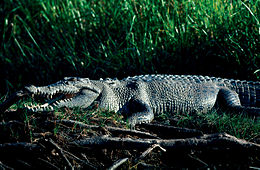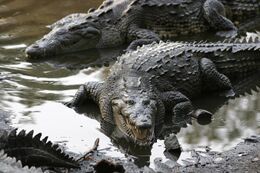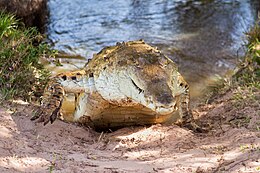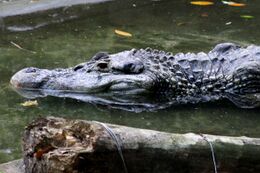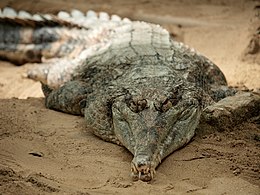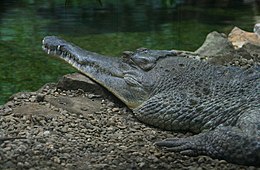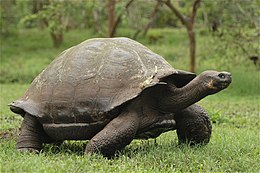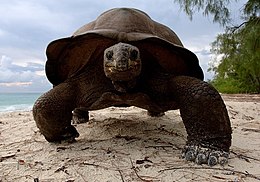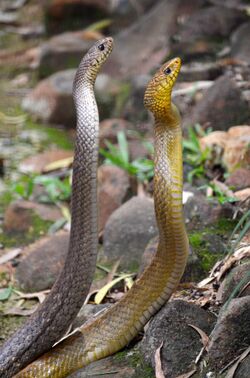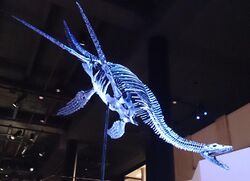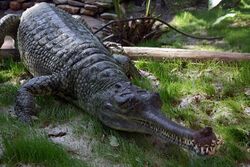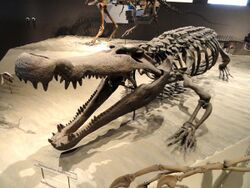Biology:List of largest reptiles
This list of largest reptiles takes into consideration both body length and mass of large reptile species, including average ranges and maximum records. The league comprises predominantly living crocodilians reaching a length of 4 m (13 ft) and a mass of 500 kg (1,100 lb) or more. It is worth mentioning that unlike the upper weight of mammals, birds or fish, mass in reptiles is frequently poorly documented, thus subject to conjecture and estimation.[1]
The saltwater crocodile is considered to be the largest extant reptile, verified at up to 6.32 m (20.7 ft) in length and around 1,000–1,500 kg (2,200–3,300 lb) in mass.[2] Larger specimens have been reported albeit not fully verified,[3] the maximum of which is purportedly 7 m (23 ft) long with an estimated mass of 2,000 kg (4,400 lb).[1]
The following table below lists the 15 largest extant reptile species ranked according to their average mass range, with maximum reported/reliable/estimated mass also being provided.
Overall
| Rank | Species | Image | Mass range [kg] | Maximum mass [kg] | Maximum length [m] |
|---|---|---|---|---|---|
| 1 | Saltwater crocodile | 400 – 1,300[2][4] | 2,000[2] | 7[5] | |
| 2 | Nile crocodile[6][7][8][9] | 250 – 900[10][11] | 1,090[6] | 6.5[6] | |
| 3 | American crocodile | 150 – 600[12] | 1,283[13] | 7[14] | |
| 4 | Orinoco crocodile | 200 – 700[15][16] | 1,100 | 7[17] | |
| 5 | Black caiman | 300 – 500[18] | 1,100[19][20] | 6[21][22] | |
| 6 | American alligator | 200 – 500[23][24] | 1,000[1] | 5.8 | |
| 7 | Gharial | 160 – 680[25][26] | 1,000[27] | 7[28] | |
| 8 | Leatherback sea turtle | 200 – 500[29][30] | 961.1[31] | 3 | |
| 9 | False gharial | 100 – 590[32][33][34] | 800[35] | 7[36] 7 | |
| 10 | Mugger crocodile | 160 – 450[37] | 700[38] | 5.63 | |
| 11 | Slender-snouted crocodile | 125 - 325[39][40][41] | 667[42] | 4.5[43] | |
| 12 | Loggerhead sea turtle | 100 – 350[44][45][46] | 545[47] | 2.1[47] | |
| 13 | Green sea turtle | 100–320 | 500[48][49] | 1.8 | |
| 14 | Galapagos tortoise | 150 – 300[50][51] | 417[52] | 1.8 | |
| 15 | Aldabra giant tortoise | 132 – 250[53] | 360[1] | 1.5 |
Lizards and snakes (Squamata)

- The most massive living member of this highly diverse reptilian order is the green anaconda (Eunectes murinus) of the neotropical riverways. These may exceed 6 m (20 ft) and 200 kg (440 lb), although such reports are not fully verified.[54] Rumors of larger anacondas also persist.[55] The reticulated python (Malayopython reticulatus) of Southeast Asia is longer but more slender, and has been reported to measure as much as 8 m (26 ft) in length and weigh up to 168 kg (370 lb).[1][56][57] The Burmese python, a south-east Asian species is known to reach up to 6 m (20 ft) and weigh as much as 150 kg (330 lb) and is generally among the three heaviest species of snakes.[58] Several other species of python can reach or exceed 6 m (20 ft) in length and 90 kg (200 lb) in weight. The fossil of the largest snake ever, the extinct boa Titanoboa were found in coal mines in Colombia. This snake was estimated to reach a length of 12.8 m (42 ft) and weighed about 1,135 kg (2,502 lb).[59]
- Among the colubrids, the most diverse snake family, the largest snake may be the keeled rat snake (Ptyas carinata) at up to 4 m (13 ft).[60] The Indian rat snake (Ptyas mucosa) is also very large with maximum sizes of up to 3.7 m (12 ft), making it the second-largest species in the genus Ptyas.[61][62] The Tiger rat snake (Spilotes pullatus), which usually grows to about 3 m (10 ft), has been reported to reach up to 4.2 m (14 ft), ranking it among the largest colubrids.[63] The genus Drymarchon also contains some of the largest colubrids such as the Eastern indigo snake and the indigo snake (Drymarchon corais) which can both reach lengths of more than 3 m (10 ft). Few other species in the colubrid family (such as False water cobra, Brown tree snake and Pseustes sulphureus) can reach lengths of 3 m (10 ft), but they are relatively slender and generally do not exceed 5 kg (11 lb) in weight.

- The longest venomous snake is the king cobra (Ophiophagus hannah), with lengths (recorded in captivity) of up to 5.7 m (19 ft) and a weight of up to 12.7 kg (28 lb).[1] It is also the largest elapid. The second-longest venomous snake in the world is possibly the African black mamba (Dendroaspis polylepis), which can grow up to 4.5 m (15 ft). Among the genus Naja, the longest member arguably may be the forest cobra (Naja melanoleuca), which can reportedly grow up to 3.2 m (10.5 ft). The King brown snake, reaching lengths of up to 3.3 m (11 ft) and weights of 8 kg (18 lb) or more, is the largest venomous snake in Australia .[64] The Yellow sea snake (Hydrophis spiralis) is the largest of the sea snakes growing up to a length of 3 m (10 ft). Few other elapids can reach or exceed 3 m (10 ft) in length and 9 kg (20 lb) in weight.[65][66]
- The Gaboon viper, a very bulky species with a maximum length of around 2.1 m (7 ft), is typically the heaviest non-constrictor snake and the biggest member of the viper family, with unverified specimens reported to as much as 20 kg (44 lb).[1][67] The Eastern diamondback rattlesnake is nearly as large, with the maximum length being 2.4 m (8 ft) and maximum weight being 15.4 kg (34 lb). The rattlesnake genus Crotalus, which includes the aforementioned eastern diamondback rattlesnake and western diamondback rattlesnake (Crotalus atrox), reaches a maximum length of 2.13 m (7 ft), and according to W. A. King one large specimen had a length of 2.26 m (7.4 ft) and a mass of 11 kg (24 lb).[68] The third largest rattlesnake is the Mexican west coast rattlesnake (Crotalus basiliscus), which reaches 2.04 m (7 ft) long and 7.7 kg (17 lb) mass,[68] and one captive-raised male was weighed at 8.8 kg (19.4 lb) in 2020.[69] While not quite as heavy, other members of the viper family are longer still, the South American bushmaster (Lachesis muta) and Central American bushmaster (Lachesis stenophrys), with a maximum length in the range of 3 to 4 m (10 to 13 ft), with the former being considered as the third-longest venomous snake in the world.[70]
- The largest of the monitor lizards (and the largest extant lizard in genera) is the Komodo dragon (Varanus komodoensis), endemic to the island of its name, at a maximum size of 3.13 m (10.3 ft) long and 166 kg (366 lb), although this is currently the only record that places the mass above 100 kg (220 lb).[1] Crocodile monitor (Varanus salvadorii) is probably the longest living lizard, known to grow as much as 3.23 m (10.6 ft), with reported lengths of up to 4.8 m (16 ft) and weights of up to 90 kg (200 lb).[71][72][73] The Asian water monitor is also one of the largest lizards in the world, with sizes of up to 3.21 m (10.5 ft) and reported weights of up to 90 kg (200 lb).[74] Few other species (such as perentie and nile monitor) can reach or possibly exceed 2.4 m (8 ft) in length and 20 kg (44 lb) in weight. The prehistoric Australian megalania (Varanus priscus), which may have existed up to 40,000 years ago, is the largest terrestrial lizard known to exist, but the lack of a complete skeleton has resulted in a wide range of size estimates. Molnar's 2004 assessment resulted in an average weight of 320 kg (710 lb) and length of 4.5 m (15 ft), and a maximum of 1,940 kg (4,280 lb) at 7 m (23 ft) in length, which is toward the high end of the early estimates.[75]

- Iguanas are very large lizards, some of which can reach lengths of up to 2 m (6.6 ft) and weigh more than 10 kg (22 lb). They are the largest lizards after some large species of monitor lizards, and the largest lizards in the New World. Iguanas vary considerably in size and form, but even the smallest lizards in this family are still quite large. Many sources describe the green iguana (Iguana iguana) as the largest iguanid, often reaching lengths up to 1.5 metres (4.91 ft) and masses of 4 kg (8.8 lb),[76] and with a maximum length of 2 m (6.6 ft) and a mass of 8 kg (18 lb)[77] and in some cases even 9.1 kg (20 lb). However, the heaviest species in this family is the blue iguana (Cyclura lewisi), with a total length of up to 1.5 m (4.91 ft), a SVL of 51–76 cm (30 in) and a mass of up to 14 kg (31 lb)[77][78] It is the eighth-heaviest and largest extant lizard.[79] Other large species in this family include the Galapagos land iguana (Conolophus subcristataus), with a length of about 1.5 m (4.91 ft) and a mass of up to 13 kg (29 lb).[80][81] It is the second-heaviest iguanid after the blue iguana and the ninth-heaviest and largest lizard in the world.[79] Another large species from the same genus is the Santa Fe land iguana (Conolophus pallidus), reaching a SVL of 56.4 cm (22.2 in) and a mass of 7.2 kg (16 lb).[82] The Galapagos pink land iguana (Conolophus marthae) have snout-vent length 57.5 cm (22.6 in) and the mass of 8 kg (18 lb).[82] The marine iguana (Amblyrhynchus cristatus) is also among the largest iguanas in the world,[79] and the largest reptile on Galapagos Islands after the Galapagos land iguana, not including turtles reaching a maximum total length of 1.4 m (4.59 ft), a SVL of from 12 till 56 cm (from 4.72 till 22 in)[83][84] and a mass of from 1 to 12 kg (2.2 to 26.5 lb)[85] depending on islands.
- The largest extant gecko is the New Caledonian giant gecko (Rhacodactylus leachianus) of New Caledonia, which can grow to 14 inches in length.[86] It was surpassed in size by the extinct Kawekaweau (Hoplodactylus delcourti) of New Zealand, which grew to a length of 580 mm (23 in).[87]

- By far the largest-ever members of this order were the giant mosasaurs (including Hainosaurus, Mosasaurus, and Tylosaurus), which grew to around 17 m (56 ft) and were projected to weigh up to 20 t (44,000 lb).[88]
Tuataras (Sphenodontia)
The larger of the two extant species of the New Zealand native tuataras is the Brothers Island tuatara (Sphenodon guntheri). The maximum size is 1.4 kg (3.1 lb) and 76 cm (30 in).
Ichthyosaurs (Ichthyosauria)

Some of these marine reptiles were comparable in size to modern cetaceans. The largest ichthyosaur was the Late Triassic species Shastasaurus sikanniensis, at approximately 21 m (69 ft) long[89][90] and 81.5 t (180,000 lb) in weight.[91] This massive animal, from the Norian stage in what is now British Columbia, is considered the largest marine reptile so far found in the fossil record.[92] However, in 2018, a specimen from Lilstock was discovered to be 25 percent larger, approximately 26 m (85 ft) in length, making it the largest marine reptile to have ever lived,[93] with some believing to even dethrone the blue whale in size.[94][95] Shonisaurus popularis is another enormous ichthyosaur. It reached 15 m (49 ft) in length and 29.7 t (65,000 lb) in weight.[90] Cymbospondylus youngorum is the largest Middle Triassic ichthyosaur, with 17.65 m (57.9 ft) in length and 45 t (99,000 lb) in weight.[91] In 2022 the tooth of a giant predatory ichthyosaur (unofficially named Swiss Tyrant) was discovered in the Swiss Alps. Based on crown diameter, the animal was about 18 m (59 ft) long and weighed 55 t (121,000 lb), making it one of the largest marine reptiles ever. [2]
Pantestudines
Turtles and tortoises (Testudines)
- The largest extant turtle is the leatherback sea turtle (Dermochelys coriacea), reaching a maximum total length of 3 m (10 ft) and a weight of 961 kg (2,119 lb).[1][96] The second-largest extant testudine is the Loggerhead sea turtle. It tends to weight slightly more average weight than the green sea turtle, and reaches more massive top sizes. The Loggerhead sea turtle (Caretta caretta) reaches a maximum size of 2.1 m (7 ft) and weight of 545 kg (1,202 lb), while the Green sea turtle (Chelonia mydas) reaches a maximum weight in the range of 395 to 500 kg (871 to 1,102 lb).[47] The Flatback sea turtle (Natator depressus) may reach a weight of up to 350 kg (770 lb).[97] Other species of Sea turtles are small-medium in size, but are still considered as large-sized for a typical turtle.

- The largest extant freshwater turtle is possibly the North American alligator snapping turtle (Macrochelys temminckii), which has an unverified maximum reported weight of 183 kg (403 lb), although this is challenged by several rare, giant softshell turtle from Asia (Rafetus and Pelochelys) unverified to 200 kg (440 lb) and nearly 2 m (6 ft 7 in) in total length.[1][98][99] The Yangtze giant softshell turtle (Rafetus swinhoei), a critically endangered species of softshell turtle, is sometimes considered as the largest extant freshwater turtle. The heaviest recorded specimen was reported to weigh 250 kg (550 lb). Some researchers have claimed that a related species, the Asian giant softshell turtle (Pelochelys cantorii), is the largest living species of freshwater turtle. However, such claims are fraught with problems, because it now seems likely that this species is actually a composite, i.e., consisting of several separate, presently undifferentiated species that have all been traditionally but erroneously lumped together taxonomically as a single species.[100] In the genus chitra, two species of critically endangered turtles have been reported to grow to massive sizes. The Asian narrow-headed softshell turtle (Chitra chitra), at up to 254 kg (560 lb), and the Indian narrow-headed softshell turtle (Chitra indica), at up to 202 kg (445 lb), are also contenders for the title of the largest extant freshwater turtle.[101][102]
- The Galápagos tortoise (Chelonoidis nigra) and the Aldabra giant tortoise (Aldabrachelys gigantea) are considered the largest truly terrestrial reptiles alive today.[1] While the Aldabra tortoise averages larger at 205 kg (452 lb), the more variable-sized Galapagos tortoise can reach a greater maximum size of 400 kg (880 lb) and 1.85 m (6.1 ft) in total length.[103][104] The Aldabra giant tortoise has a maximum recorded weight of 363 kg (800 lb). The African spurred tortoise (Centrochelys sulcata) is the third-largest extant tortoise (and the largest mainland tortoise) in the world. The large adults of this species may reach 1 m (3.3 ft) in length and weigh more than 100 kg (220 lb).[105] Other relatively large-sized tortoises include the Yellow-footed tortoise (Chelonoidis denticulatus) and Leopard tortoise (Stigmochelys pardelis), at up to 54 kg (119 lb), and the Asian forest tortoise (Manouria emys), at up to 37 kg (82 lb) or more, can be rather large as well.[106][107] The tortoise Megalochelys, of the Pleistocene epoch from what is now Pakistan and India, was even larger, at nearly 2.7 m (9 ft) in shell length[108] and 0.8–1.0 t (1,800–2,200 lb).[109]
- The largest of side-necked turtles (Pleurodira) is the Arrau turtle (Podocnemis expansa). Its carapace length is up to 1.07 m (3.5 ft) and adults can reach up to 90 kg (200 lb) in weight.[110] There are also reports of these turtles weighing up to 118 kg (260 lb).[111] The Mata mata (Chelus fimbriata) is another large species of side-necked turtle with a carapace length of up to 1 m (3.3 ft) and weight of more than 21 kg (46 lb).

- There are many extinct turtles that vie for the title of the largest ever.[1] The largest freshwater turtle seems to be Stupendemys, with an estimated parasagittal carapace length of 2.86 m (9 ft 5 in) and weight of up to 1,145 kg (2,524 lb).[112] A close contender is Archelon ischyros, a sea turtle, which reached a length of 5 m (16 ft) and a weight of 2,200 kg (4,900 lb).[113]
Meiolaniformes
A terrestrial relative of turtles survived until about 2,000 years ago, the Australasian Meiolania at about 2.6 m (8 ft 6 in) long and a weight of over 1 t (2,200 lb).[1] Later research suggests the maximum length possibly over 3 m (9.8 ft).[114]
Plesiosaurs (Plesiosauria)
Plesiosaurs were aquatic reptiles of the Mesozoic era. They had a broad flat body, a short tail, and strong flippers. Most of the Plesiosauroidea group are identified by their long necks, while Pliosauroidea are usually short-necked. The largest known plesiosauroid is Aristonectes, with a body length of 10–11.86 metres (32.8–38.9 ft) and body mass of 10.7–13.5 t (24,000–30,000 lb).[115] The largest well known pliosauroid is Pliosaurus funkei at 10–13 m (33–43 ft) in length.[116]
Crocodilians (Crocodilia)
- Some species of crocodiles such as Saltwater crocodile (Crocodylus porosus), Nile crocodile (Crocodylus niloticus), American crocodile (Crocodylus acutus) and the critically endangered Orinoco crocodile (Crocodylus intermedius) can reach lengths of 6 m (20 ft) or more. The largest known specimen among the living crocodilians was an Orinoco crocodile with a length of 6.78 m (22.2 ft).[2] One of the largest known Saltwater crocodile measured 6.2 m (20.3 ft) and was shot in Papua New Guinea.[2] A 6.17 m (20.2 ft) long individual was captured alive in Mindanao in 2011.[3] The largest confirmed Saltwater crocodile on record was 6.32 m (20.7 ft) long, and weighed about 1,360 kg (3,000 lb).[117] In 2006, Guinness World Records accepted claims of a 7-metre (23 ft), 2,000-kilogram (4,400 lb) male saltwater crocodile, living within Bhitarkanika National Park.[118] Due to the difficulty of trapping and measuring a large living crocodile, the accuracy of these dimensions is yet to be verified. These observations and estimations have been made by park officials over the course of ten years, from 2006 to 2016, however, regardless of the skill of the observers it cannot be compared to a verified tape measurement, especially considering the uncertainty inherent in visual size estimation in the wild.[119] The largest Nile crocodile accurately measured, shot near Mwanza, Tanzania, measured 6.45 m (21.2 ft) and weighed about 1,043–1,089 kg (2,300–2,400 lb).[117] Another large Nile crocodile specimen was purported to be a man-eater from Burundi named Gustave; it was thought to have been more than 6.1 m (20 ft) long. The American crocodile is also one of the largest crocodile species, with large males in the southern part of their range reported to approach 6.1 m (20 ft) in size. Based on projections from various skulls, the largest males may have reached 6–7 m (20–23 ft) in length, and their predicted mass reached up to 1,283 kg (2,829 lb).[120] Other crocodiles can also grow to large sizes, such the Mugger crocodile, which typically reaches an average maximum length of 4–5 m (13–16 ft), and has a maximum reported length of 5.63 m (18.5 ft). The extinct Crocodylus thorbjarnarsoni was the largest species in its genus, growing up to 7.56 m (24.8 ft) in length.[121] The largest true crocodile ever existed is Euthecodon which estimated to have reached 6.4–8.6 m (21–28 ft) or even 10 m (33 ft) long.[122][123]
- A 6.55 m (21.5 ft) long gharial was killed in the Ghaghara River in Faizabad in August 1920.[124] Male gharials may grow up to a length of 7 m (23 ft).[125][28] The heaviest recorded gharial was a male measuring 6.25 m (20.5 ft) in total length and weighing 977 kg (2,154 lb).[126] The False gharial is also a large crocodilian with males reaching 5 m (16 ft) in length, weighing up to at least 590 kg (1,300 lb).[34] The largest gavialid to ever exist was the extinct Rhamphosuchus from the Miocene of Asia. It was originally thought to be 18 m (59 ft) long and more than 20 t (44,000 lb) in weight but later estimations suggest 10.5 m (34 ft) and 2–3 t (4,400–6,600 lb). Based on its fossils, the latter species was less massive and heavy than the other giant crocodilians, weighing an estimated 3 t (6,600 lb).[127][128]
- The largest member of the family Alligatoridae is the Black caiman (Melanosuchus niger) with the American alligator (Alligator mississippiensis) sometimes growing to similar lengths. Black caimans can reach more than 5 m (16 ft) in length and weigh up to 750 kg (1,650 lb).[129] American alligators can be almost as large, with males reaching 4.6 m (15 ft) in length and weighing over 500 kg (1,100 lb).[130] Unverified reports suggest lengths of up to 6 m (20 ft) for the black caiman and 5.84 m (19.2 ft) for the American alligator, reaching weights of over 1,000 kg (2,200 lb), but such lengths are probably exaggerated.
- The giant prehistoric caiman, Purussaurus, from northern South America during the Miocene epoch grew up to 10–12 m (33–39 ft) long and could weigh up to 8 tonnes, making it one of the largest crocodilians ever.[131][132] Other contenders for the largest crocodilian ever include the late Cretaceous period Deinosuchus, at up to 12 m (39 ft) and 8.5 t (19,000 lb).[133] Relative of crocodilians, Sarcosuchus imperator of the early Cretaceous was found in the Sahara desert and could measure up to 9 m (30 ft) and weigh an estimated 3.5 t (7,700 lb).[134]
Pterosaurs (Pterosauria)
A Mesozoic reptile is believed to have been the largest flying animal that ever existed: the pterosaur Quetzalcoatlus northropi, from North America during the late Cretaceous. This species is believed to have weighed up to 126 kg (278 lb), measured 7.9 m (26 ft) in total length (including a neck length of over 3 m (9.8 ft)) and measured up to 10–12 m (33–39 ft) across the wings.[135][136] Another possible contender for the largest pterosaur is Hatzegopteryx, which is estimated to have had an 11–12 m (36–39 ft) wingspan.[136][135] An unnamed Mongolian pterodactyloid pterosaur[137] and Arambourgiania from Jordan could reach a wingspan of nearly 10 m (33 ft).[138]
Non-avian dinosaurs (Dinosauria)

- The main contender for the longest sauropod and the longest known vertebrate is Maraapunisaurus fragillimus. Known only by lost vertebra, it was estimated at 58 m (190 ft) in length and 122.4 t (270,000 lb) in weight[139] but later studies suggest smaller size, about 35 m (115 ft) in length and 70 t (150,000 lb) in weight.[140] Breviparopus taghbaloutensis was mentioned in The Guinness Book of Records as the longest dinosaur at 48 m (157 ft) but this animal is known only from fossil tracks.[141][142] The better studied Supersaurus was possibly as long as over 40 m (130 ft).[143] One of the heaviest sauropods was Argentinosaurus at 35 m (115 ft) in length and 65–75 t (143,000–165,000 lb)[140][144] or even 100 t (220,000 lb) in body mass.[140] The tallest sauropods were probably Xinjiangtitan and Sauroposeidon with total height of 17 m (56 ft) and 16.5–18 m (54–59 ft), respectively.[140][145][146]
- The largest non-avian theropod was Tyrannosaurus Rex, estimated at 12.1–12.2 m (40–40 ft) in length and around 8–10.6 t (18,000–23,000 lb) in weight.[147][148]
- The largest thyreophoran was Ankylosaurus at 9 m (30 ft) in length and 6 t (13,000 lb) in weight.[149][150]
- The largest ceratopsian was Triceratops, reaching 8–9 m (26–30 ft) in length and 5–9 t (11,000–20,000 lb) in weight.[151][152][153]
- The largest ornithopod was the Late Cretaceous Shantungosaurus at up to 23 t (51,000 lb),[154][155] and 16.6 m (54 ft) in length.[154]
References
- ↑ 1.00 1.01 1.02 1.03 1.04 1.05 1.06 1.07 1.08 1.09 1.10 1.11 1.12 Wood, G. (1983). The Guinness Book of Animal Facts and Feats. Guinness Superlatives. p. 256. ISBN 978-0-85112-235-9. https://archive.org/details/guinnessbookofan00wood.
- ↑ 2.0 2.1 2.2 2.3 2.4 Whitaker, R.; Whitaker, N. (2008). "Who's got the biggest?". Crocodile Specialist Group Newsletter 27 (4): 26–30. https://www.iucncsg.org/365_docs/attachments/protarea/907d4ded022a4ddefe525f89ee64b150.pdf.
- ↑ 3.0 3.1 Britton, A. R. C.; Whitaker, R.; Whitaker, N. (2012). "Here be a Dragon: Exceptional Size in Saltwater Crocodile (Crocodylus porosus) from the Philippines". Herpetological Review 43 (4): 541–546. https://www.academia.edu/36041486.
- ↑ Ogamba, E.N. and Abowei, JFN (July 2012). Some Aquatic Reptiles in Culture Fisheries Management. International Journal of Fishes and Aquatic Sciences. pp. 5–15. https://www.researchgate.net/publication/267199117.
- ↑ Webb, G. J.; Hollis, G. J.; Manolis, S. C. (1991). "Feeding, growth, and food conversion rates of wild juvenile saltwater crocodiles (Crocodylus porosus)". Journal of Herpetology 25 (4): 462–473. doi:10.2307/1564770.
- ↑ 6.0 6.1 6.2 Wood, G. (1983). The Guinness Book of Animal Facts and Feats. Sterling Pub Co Inc. ISBN:978-0-85112-235-9
- ↑ Guggisberg, C.A.W. (1972). Crocodiles: Their Natural History, Folklore, and Conservation. p. 195. ISBN 978-0-7153-5272-4.
- ↑ Brazaitis, P. (1989). The forensic identification of crocodilian hides and products. In: Crocodiles: Their Ecology, Management, and Conservation. IUCN Special Publication of Crocodile Specialist Groups of the Species Survival Commission. pp. 17–43.
- ↑ Graham, A. D. (1968). The Lake Rudolf Crocodile (Crocodylus niloticus Laurenti) Population. Masters of Science Thesis, The University of East Africa.
- ↑ Stefanie B. Ganswindt (October 2012). Non-invasive assessment of adrenocortical function in captive Nile crocodiles (Crocodylus niloticus) and its relation to housing conditions. University of Pretoria. https://repository.up.ac.za/bitstream/handle/2263/25143/dissertation.pdf?sequence=1.
- ↑ "Nile Crocodile (Crocodylus niloticus)". http://wildliferanching.com/content/nile-crocodile-crocodylus-niloticus.
- ↑ "TERRAPENE CAROLINA TRIUNGUIS (Three-toed Box." Herpetological Review, 41(4). ORNATA, T. O.. pp. 489. https://www.researchgate.net/publication/259970728.
- ↑ FESTIVA, AMEIVA and Ameivafestiva (December 2010). Herpetological Review. pp. 490. https://www.researchgate.net/publication/283713102.
- ↑ Jake Fishman. "ADW: Crocodylus acutus: INFORMATION". Animal Diversity Web. http://animaldiversity.ummz.umich.edu/accounts/Crocodylus_acutus/.
- ↑ Orinoco crocodile videos, photos and facts – Crocodylus intermedius . ARKive
- ↑ Zoo, Gladys Porter. "Critically Endangered Orinoco Crocodiles Coming to Gladys Porter Zoo". www.prnewswire.com (Press release).
- ↑ WAZA. "Orinoco Crocodile". http://www.waza.org/en/zoo/choose-a-species/reptiles/crocodiles/crocodylus-intermedius.
- ↑ French Guiana. kwata.net (2003).
- ↑ Vliet, Kent A. (3 March 2020) (in en). Alligators: The Illustrated Guide to Their Biology, Behavior, and Conservation. JHU Press. pp. 150. ISBN 978-1-4214-3338-7. https://books.google.com/books?id=0UDLDwAAQBAJ&dq=Alligators:+The+illustrated&pg=PP1.
- ↑ Chris Johnson, Sarah R. Anderson, James Moore, David Warrell, Jon Dallimore, Chris Imray · (2015). Oxford handbook of expedition and wilderness medicine (2nd ed.). Oxford: Oxford University Press. pp. 545. ISBN 9780199688418. https://global.oup.com/academic/product/oxford-handbook-of-expedition-and-wilderness-medicine-9780199688418?cc=us&lang=en&.
- ↑ Black Caiman, Black Caiman Skull. Dinosaurcorporation.com. Retrieved on 2012-08-23.
- ↑ Crocodilian Species – Black Caiman (Melanosucus niger). Crocodilian.com. Retrieved on 2012-08-23.
- ↑ Martonos, Cristian; Dumitru, Ioana; Dezdrobitu, Cristian; Blendea, Alexandra; Irimescu, Irina; Damian, Aurel (2014). "Anatomical Studies Concerning the Skeleton of the Head in the Alligator (Alligator mississippiensis)" (in English). Bulletin of University of Agricultural Sciences and Veterinary Medicine Cluj-Napoca. Veterinary Medicine. ISSN 1843-5270. https://agris.fao.org/agris-search/search.do?recordID=RO2014100452.
- ↑ "American Alligator". 25 April 2016. http://nationalzoo.si.edu/animals/reptilesamphibians/facts/factsheets/americanalligator.cfm.
- ↑ Stevenson, C.; Whitaker, R. (2010). "Gharial Gavialis gangeticus". Crocodiles. Status Survey and Conservation Action Plan (Third ed.). Darwin: Crocodile Specialist Group. pp. 139–143. http://www.iucncsg.org/365_docs/attachments/protarea/23_G-6764939a.pdf.
- ↑ "Gavial". https://www.aquaticcommunity.com/gavials/Gharial.php.
- ↑ Gavials (Gharials), Gavial (Gharial) Pictures, Gavial (Gharial) Facts. Animals.nationalgeographic.com
- ↑ 28.0 28.1 "Gharial". http://www.wwfindia.org/about_wwf/priority_species/gharial/.
- ↑ Leatherback Sea Turtle. euroturtle.org
- ↑ "AquaFacts". http://www.vanaqua.org/education/aquafacts/leatherbacks.html.
- ↑ "Largest turtle/chelonian". https://www.guinnessworldrecords.com/world-records/largest-chelonian.
- ↑ http://www.zoonegaramalaysia.my/RPFalseGharial.pdf [bare URL PDF]
- ↑ Erickson, Gregory M.; Gignac, Paul M.; Steppan, Scott J.; Lappin, A. Kristopher; Vliet, Kent A.; Brueggen, John D.; Inouye, Brian D.; Kledzik, David et al. (14 March 2012). "Insights into the Ecology and Evolutionary Success of Crocodilians Revealed through Bite-Force and Tooth-Pressure Experimentation". PLOS ONE 7 (3): e31781. doi:10.1371/journal.pone.0031781. ISSN 1932-6203. PMID 22431965. Bibcode: 2012PLoSO...731781E.
- ↑ 34.0 34.1 Ahmad, A. A.; Dorrestein, G. M.; Oh, S. J. W. Y.; Hsu, C. D. (1 August 2017). "Multi-organ Metastasis of Fibrolamellar Hepatocellular Carcinoma in a Malayan Gharial (Tomistoma schlegelii)" (in en). Journal of Comparative Pathology 157 (2): 80–84. doi:10.1016/j.jcpa.2017.06.007. ISSN 0021-9975. PMID 28942308. https://www.sciencedirect.com/science/article/abs/pii/S0021997517301408.
- ↑ "False gharial – Tommy". https://www.lafermeauxcrocodiles.com/en/animaux/faux-gavial-tommy-3/.
- ↑ Kyle Shaney, Bruce Shwedick, Boyd Simpson and Colin Stevenson. Tomistoma (Tomistoma schlegelii). Crocodile Specialist Group (IUCN). http://www.iucncsg.org/content_images/attachments/species_descriptions/Tomistoma.pdf.
- ↑ "Marsh Crocodile" (in en). https://www.wii.gov.in/nmcg/priority-species/reptiles/marsh-crocodile.
- ↑ Lang, J. W.; Andrews, H.; Whitaker, R. (1989). "Sex determination and sex ratios in Crocodylus palustris". American Zoologist 29 (3): 935–952. doi:10.1093/icb/29.3.935.
- ↑ "African Slender-Snouted Crocodile – The Maryland Zoo in Baltimore". The Maryland Zoo in Baltimore. http://www.marylandzoo.org/animals-conservation/reptiles/african-slender-snouted-crocodile/.
- ↑ "Slender-Snouted Crocodile – San Diego Zoo Animals". http://www.sandiegozoo.org/animalbytes/t-slender_crocodile.html.
- ↑ "African Slender-snouted Crocodile". https://www.marylandzoo.org/animal/african-slender-snouted-crocodile/.
- ↑ Michael J. Lynch, Stephen F. Pires (2019). Quantitative studies in green and conservation criminology : the measurement of environmental harm and crime. Abingdon, Oxon: Taylor & Francis. pp. 96. ISBN 9780429844232. https://books.google.com/books?id=ZTr3DwAAQBAJ&dq=quantitative+studies+in+green+and+conservation+criminology&pg=PP1.
- ↑ J Milan, R Hedegaard (2010). Interspecific variation in tracks and trackways from extant crocodylians. New Mexico Museum of Natural History and Science Bulletin. pp. 15–29. https://www.researchgate.net/publication/258860197.
- ↑ "Loggerhead Turtle | Sea Turtles | Species | WWF" (in en). https://www.worldwildlife.org/species/loggerhead-turtle.
- ↑ "ECOS: Species Profile". https://ecos.fws.gov/ecp/species/C00U.
- ↑ "Loggerhead sea turtle, facts and photos" (in en). 11 April 2010. https://www.nationalgeographic.com/animals/reptiles/facts/loggerhead-sea-turtle.
- ↑ 47.0 47.1 47.2 "Largest hardshell sea turtle" (in en-gb). 6 March 2018. https://www.guinnessworldrecords.com/world-records/517469-largest-hardshell-sea-turtle.
- ↑ Wood, S. C.; Gatz, R. N.; Glass, M. L. (1 April 1984). "Oxygen transport in the green sea turtle" (in en). Journal of Comparative Physiology B 154 (3): 275–280. doi:10.1007/BF02464407. ISSN 1432-136X. https://link.springer.com/article/10.1007/BF02464407.
- ↑ Gatz, R. N.; Glass, M. L.; Wood, S. C. (1 February 1987). "Pulmonary function of the green sea turtle, Chelonia mydas" (in en). Journal of Applied Physiology 62 (2): 459–463. doi:10.1152/jappl.1987.62.2.459. ISSN 8750-7587. PMID 3558205. https://journals.physiology.org/doi/abs/10.1152/jappl.1987.62.2.459.
- ↑ ADW: Geochelone nigra: Information. Animaldiversity.ummz.umich.edu
- ↑ Bastille-Rousseau, Guillaume; Yackulic, Charles B.; Frair, Jacqueline L.; Cabrera, Freddy; Blake, Stephen (September 2016). "Allometric and temporal scaling of movement characteristics in Galapagos tortoises" (in en). Journal of Animal Ecology 85 (5): 1171–1181. doi:10.1111/1365-2656.12561. ISSN 0021-8790. PMID 27336221.
- ↑ "Largest tortoise (specimen)" (in en-gb). https://www.guinnessworldrecords.com/world-records/70251-largest-tortoise.
- ↑ "Aldabra tortoise". 25 April 2016. https://nationalzoo.si.edu/animals/aldabra-tortoise.
- ↑ Barker, David G.; Barten, Stephen L.; Ehrsam, Jonas P.; Daddono, Louis (2012). "The Corrected Lengths of Two Well-known Giant Pythons and the Establishment of a new Maximum Length Record for Burmese Pythons, Python bivittatus". Bulletin Chicago Herpetology Society 47 (1): 1–6. http://www.vpi.com/sites/default/files/Barker-et-al_CorrectPythonLengths_2.pdf. Retrieved 2016-02-04.
- ↑ Green Anacondas, Green Anaconda Pictures, Green Anaconda Facts. Animals.nationalgeographic.com
- ↑ Cotswold Wildlife Park and Gardens | Reticulated python. Cotswoldwildlifepark.co.uk
- ↑ "Largest albino snake in captivity" (in en-gb). 7 December 2012. https://www.guinnessworldrecords.com/world-records/106228-largest-albino-snake-in-captivity.
- ↑ "Burmese Python | National Geographic" (in en). 10 September 2010. https://www.nationalgeographic.com/animals/reptiles/facts/burmese-python.
- ↑ Head, J. J.; Bloch, J. I.; Hastings, A. K.; Bourque, J. R.; Cadena, E. A.; Herrera, F. A.; Polly, P. D.; Jaramillo, C. A. (2009). "Giant boid snake from the Palaeocene neotropics reveals hotter past equatorial temperatures". Nature 457 (7230): 715–717. doi:10.1038/nature07671. PMID 19194448. Bibcode: 2009Natur.457..715H.
- ↑ "Keeled Rat Snake – Ptyas carinata – Not Dangerous | Thailand Snakes". 20 January 2013. https://www.thailandsnakes.com/aglyph/keeled-rat-snake-ptyas-carinata-not-dangerous/.
- ↑ Auliya, M. (2010). Conservation Status and Impact of Trade on the Oriental Rat Snake Ptyas mucosa in Java, Indonesia. TRAFFIC Southeast Asia.
- ↑ Das, I. (2015). A field guide to the reptiles of South-East Asia. Bloomsbury Publishing.
- ↑ Spilotes pullatus (Tiger Rat Snake or Clibo). The Online Guide to the Animals of Trinidad and Tobago. https://sta.uwi.edu/fst/lifesciences/sites/default/files/lifesciences/documents/ogatt/Spilotes_pullatus%20-%20Tiger%20Rat%20Snake%20or%20Clibo.pdf.
- ↑ Beatson, Cecilie (25 November 2018). "Mulga Snake". Animal Species. Australian Museum. https://australianmuseum.net.au/learn/animals/reptiles/mulga-snake/.
- ↑ "Oxyuranus scutellatus – General Details". Clinical Toxinology Resource. University of Adelaide. http://www.toxinology.com/fusebox.cfm?fuseaction=main.snakes.display&id=SN0518. Retrieved 17 April 2012.
- ↑ Australian Broadcasting Corporation (3 October 2014). "Massive red-bellied black snake surprises Newcastle wrangler called in to remove it". ABC News. http://www.abc.net.au/news/2014-10-02/snake-wrangler-catches-massive-red-bellied-black-snake-newcastle/5786950.
- ↑ Gaboon Viper, Bitis gabonica . California Academy of Sciences
- ↑ 68.0 68.1 Laurence M. Klauber (1972). Rattlesnakes: Their Habits, Life Histories, and Influence on Mankind. 1. University of California Press. ISBN 0-520-01775-7.
- ↑ Monster Basiliscus Weighed – 20 lb Rattlesnake. SnakeBytesTV. April 1, 2020. Retrieved 2022-06-27.
- ↑ Mehrtens JM. 1987. Living Snakes of the World in Color. New York: Sterling Publishers. ISBN:0-8069-6460-X.
- ↑ Wood, Gerald (1983). The Guinness Book of Animal Facts and Feats. ISBN:978-0-85112-235-9.
- ↑ "Longest lizard" (in en-gb). https://www.guinnessworldrecords.com/world-records/70285-longest-lizard.
- ↑ Wojtasek, Gregory. "Varanus salvadorii (Crocodile Monitor)" (in en). https://animaldiversity.org/accounts/Varanus_salvadorii/.
- ↑ "The Largest Monitor Lizards by Paleonerd01 on DeviantArt" (in en). 18 August 2019. https://www.deviantart.com/paleonerd01/journal/The-Largest-Monitor-Lizards-810103049.
- ↑ Molnar, R. E. (2004). "The Long and Honorable History of Monitors and Their Kin". Varanoid Lizards of the World. Indiana University Press. p. 588. ISBN 978-0-253-34366-6. http://www.iupress.indiana.edu/catalog/product_info.php?products_id=21751.
- ↑ Rivas, J.A. (2008). Pers. comm.
- ↑ 77.0 77.1 Roger Klingenberg, Philippe De Vosjoli; David Blair., Susan Donoghue (2003). The Green Iguana Manual. BowTie Press. pp. 111. ISBN 1882770676.
- ↑ Dorge, Ray (1996). "A Tour of the Grand Cayman Blue Iguana Captive-Breeding Facility". Reptiles: Guide to Keeping Reptiles and Amphibians 4 (9): 32–42.
- ↑ 79.0 79.1 79.2 "The 10 Largest Lizards in The World". 18 August 2021. https://a-z-animals.com/blog/largest-lizards/.
- ↑ Rogers, Barbara (1990), Galapagos, New York: Mallard Press, pp. 144, ISBN 978-0-7924-5192-1
- ↑ Rosenthal, Ellen (1997), "Days and nights of the iguana: in the Galapagos, a devoted pair work to save land iguanas", Animals, http://findarticles.com/p/articles/mi_m0FRO/is_n4_v130/ai_19634764
- ↑ 82.0 82.1 Cruz M. Márquez B. (June 2010). "Estado poblacional de las iguanas terrestres (Conolophus subcristatus, C. pallidusy C.marthae: Squamata, Iguanidae), Islas Galápagos" (in es). Boletín Técnico, Serie Zoológica (Sangolquí, Équateur: ESPE) 9: pp. 19–37. https://journal.espe.edu.ec/ojs/index.php/revista-serie-zoologica/article/viewFile/1427/1015#page=3..
- ↑ Miralles; Macleod; Rodríguez; Ibáñez; Jiménez-Uzcategui; Quezada; Vences; Steinfartz (2017). "Shedding Light On the Imps of Darkness: An Integrative Taxonomic Revision of the Galápagos Marine Iguanas (Genus Amblyrhynchus)". Zoological Journal of the Linnean Society XX (3): 1–33. doi:10.1093/zoolinnean/zlx007.
- ↑ Wikelski, M.; Trillmich, F. (1997). "Body Size and Sexual Size Dimorphism in Marine Iguanas Fluctuate as a Result of Opposing Natural and Sexual Selection: An Island Comparison". Evolution 51 (3): 922–936. doi:10.1111/j.1558-5646.1997.tb03673.x. PMID 28568579.
- ↑ Endangered animals of the world pp. 48
- ↑ Allison Ballance and Rod Morris, "Island Magic; wildlife of the south seas", David Bateman publishing, 2003
- ↑ Wilson, Kerry-Jayne (2004). Flight of the Huia: Ecology and Conservation of New Zealand's Frogs, Reptiles, Birds and Mammals. Christchurch, N.Z: Canterbury University Press. pp. 411. ISBN 978-0-908812-52-3.
- ↑ Science & Nature – Sea Monsters – Fact File: Giant Mosasaur. BBC (2005-08-26)
- ↑ "Triassic Giant". http://www.tyrrellmuseum.com/exhibits/triassic_giant.htm.
- ↑ 90.0 90.1 Sander, P.M.; Romero Pérez de Villar, P.; Furrer, H.; Wintrich, T. (2022). "Giant Late Triassic Ichthyosaurs from the Kössen Formation of the Swiss Alps and Their Paleobiological Implications". Journal of Vertebrate Paleontology 41 (6): e2046017. doi:10.1080/02724634.2021.2046017. https://www.parc-ela.ch/sites/parc_ela/files/2022-05/Sander%20et%20al.%202022_02724634.2021.pdf.
- ↑ 91.0 91.1 Sander, P.M.; Griebeler, E.M.; Klein, N.; Juarbe, J.V.; Wintrich, T.; Revell, L.J.; Schmitz, L. (2021). "Early giant reveals faster evolution of large body size in ichthyosaurs than in cetaceans". Science 374 (6575): eabf5787. doi:10.1126/science.abf5787. PMID 34941418. http://www.faculty.umb.edu/liam.revell/pdfs/Sander_etal_2021.Science.pdf.
- ↑ Nicholls, E. L.; Manabe, M. (2004). "Giant ichthyosaurs of the Triassic—a new species of Shonisaurus from the Pardonet Formation (Norian: Late Triassic) of British Columbia". Journal of Vertebrate Paleontology 24 (4): 838–849. doi:10.1671/0272-4634(2004)024[0838:GIOTTN2.0.CO;2].
- ↑ "Researchers have found a 205-million-year-old jawbone from one of the largest animals that ever lived". 9 April 2018. http://www.newsweek.com/giant-ichthyosaur-205-million-year-old-jawbone-discovered-one-largest-animals-877542?yptr=yaho.
- ↑ De la Salle, Paul; R. Lomax, Dean; A. Massare, Judy; Gallois, Ramues (2018). "A giant Late Triassic ichthyosaur from the UK and a reinterpretation of the Aust Cliff 'dinosaurian' bones". PLOS ONE 13 (4). doi:10.6084/m9.figshare.5975440. https://journals.plos.org/plosone/article?id=10.1371/journal.pone.0194742.
- ↑ Pickrell, John (2018). "Prehistoric 'Sea Monster' May Be Largest That Ever Lived". https://www.nationalgeographic.com/science/article/prehistoric-sea-monster-largest-size-blue-whale-fossils-science.
- ↑ "Largest turtle/chelonian" (in en-gb). https://www.guinnessworldrecords.com/world-records/largest-chelonian.
- ↑ Hoagland, Porter; Steele, John H.; Thorpe, Steve A.; Turekian, Karl K. (2010) (in en). Marine Policy & Economics. Academic Press. pp. 162. ISBN 978-0-08-096481-2. https://books.google.com/books?id=dqzXwFsOFMcC&pg=PA161.
- ↑ Lukas I. Alpert Sacred century-old turtle pulled from Vietnam lake in effort to save its life. New York Daily News (2011-04-04)
- ↑ Seth Mydans. "How to Survive in Cambodia: For a Turtle, Beneath Sand," New York Times (2007-05-18).
- ↑ "Largest freshwater turtle (living)" (in en-gb). 27 October 2016. https://www.guinnessworldrecords.com/world-records/448946-largest-living-freshwater-turtle.
- ↑ "Asian Narrow-headed Softshell Turtle". https://www.edgeofexistence.org/species/southeast-asian-narrow-headed-softshell-turtle/.
- ↑ "Narrow-headed Softshell Turtle". https://www.edgeofexistence.org/species/narrow-headed-softshell-turtle/.
- ↑ Ebersbach, V.K. (2001). Zur Biologie und Haltung der Aldabra-Riesenschildkröte (Geochelone gigantea) und der Galapagos-Riesenschildkröte (Geochelone elephantopus) in menschlicher Obhut unter besonderer Berücksichtigung der Fortpflanzun (PhD thesis). Hannover: Tierärztliche Hochschule. [1].
- ↑ Fritts, T.H. (1983). Morphometrics of Galapagos tortoises: evolutionary implications. In Bowman, I.R.; Berson, M.; Leviton, A.E. Patterns of evolution in Galapagos organisms. San Francisco: American Association for the Advancement of Science. pp. 107–122. ISBN:0-934394-05-9
- ↑ Pizzi, R and Goodman, G and Gunn-Moore, D and Meredith, A and Keeble, Emma (2005). Pieris japonica intoxication in an African spurred tortoise (Geochelone sulcata). London: The Association. pp. 487–488. https://www.researchgate.net/publication/7907818.
- ↑ Baker, Hillary H.; Grubb, Jordan N.. "Psammobates pardalis (Leopard Tortoise)" (in en). https://animaldiversity.org/accounts/Psammobates_pardalis/.
- ↑ Iain J. Gordon, Herbert H. T. Prins (2019). The ecology of browsing and grazing II. Berlin. pp. 339–404. ISBN 978-3-030-25865-8. https://www.researchgate.net/publication/337202219.
- ↑ Hirayama, Ren; Sonoda, Teppei; Takai, Masanaru; Htike, Thaung; Thein, Zin Maung Maung; Takahashi, Akio (6 April 2015). "Megalochelys: gigantic tortoise from the Neogene of Myanmar" (in en). PeerJ PrePrints. doi:10.7287/peerj.preprints.961v1. https://peerj.com/preprints/961v1/.
- ↑ Gregory S. Paul; Guy D. Leahy (1994). "Terramegathermy in the time of the titans: Restoring the metabolics of colossal dinosaurs". The Paleontological Society Special Publications 7: Dino Fest: 177–198. doi:10.1017/S2475262200009515. http://gspauldino.com/TerraTimeofTitans.pdf.
- ↑ "Podocnemis expansa". INCT CENBAM, INPA. https://ppbio.inpa.gov.br/en/Cheloniateca/Podocnemis_expansa.
- ↑ Cesar L. Barrio-Amoros, Ínigo Narbaiza (2008). Turtles of the Venezuelan Estado Amazonas. Radiata 17(1). pp. 2–19. https://www.academia.edu/download/7899286/TURTLES%20OF%20VENEZUELAN%20AMAZONAS_BARRIONARBAIZA.pdf.
- ↑ Cadena, E.-A.; Scheyer, T.M.; Carrillo-Briceño, J.D.; Sánchez, R.; Aguilera-Socorro, O.A.; Vanegas, A.; Pardo, M.; Hansen, D.M. et al. (12 Feb 2020). "The anatomy, paleobiology, and evolutionary relationships of the largest extinct side-necked turtle". Science Advances 6 (7): eaay4593. doi:10.1126/sciadv.aay4593. PMID 32095528. Bibcode: 2020SciA....6.4593C.
- ↑ Colston, T. J., Kulkarni, P., Jetz, W., & Pyron, R. A. (2020). "Phylogenetic and spatial distribution of evolutionary diversification, isolation, and threat in turtles and crocodilians (non-avian archosauromorphs)". BMC Evolutionary Biology 20 (1): 81. doi:10.1186/s12862-020-01642-3. PMID 32650718. PMC 7350713. https://www.researchgate.net/publication/342848355.
- ↑ Lauren E. Brown, Don Moll (October 2019). "The enigmatic palaeoecology and palaeobiogeography of the giant, horned, fossil turtles of Australasia: a review and reanalysis of the data". Herpetological Journal 29 (4): 252–263. doi:10.33256/hj29.4.252263. ISSN 0268-0130. https://www.thebhs.org/publications/the-herpetological-journal/volume-29-number-4-october-2019/1979-08-the-enigmatic-palaeoecology-and-palaeobiogeography-of-the-giant-horned-fossil-turtles-of-australasia-a-review-and-reanalysis-of-the-data/file.
- ↑ O'Gorman, J.P.; Santillana, S.; Otero, R.; Reguero, M. (2019-10-01). "A giant elasmosaurid (Sauropterygia; Plesiosauria) from Antarctica: New information on elasmosaurid body size diversity and aristonectine evolutionary scenarios" (in en). Cretaceous Research 102: 37–58. doi:10.1016/j.cretres.2019.05.004. ISSN 0195-6671. Bibcode: 2019CrRes.102...37O. https://www.sciencedirect.com/science/article/abs/pii/S0195667118302003.
- ↑ Knutsen, Espen M.; Druckenmiller, Patric S.; Hurum, Jørn H. (2012). "A new species of Pliosaurus (Sauropterygia: Plesiosauria) from the Middle Volgian of central Spitsbergen, Norway". Norwegian Journal of Geology 92: 235–258. ISSN 1502-5322. https://njg.geologi.no/images/NJG_articles/NJG_2_3_2012_13_Knutsen_etal_Scr.pdf.
- ↑ 117.0 117.1 Wood, Gerald L. (1982). The Guinness book of animal facts and feats (3rd ed.). Enfield, Middlesex: Guinness Superlatives. ISBN 978-0-85112-235-9.
- ↑ Mishra, Braja Kishore (14 June 2006). "World's Largest Reptile Found in India". ohmynews.com. http://english.ohmynews.com/articleview/article_view.asp?no=298369&rel_no=1.
- ↑ Bayliss, P. (1987). Survey methods and monitoring within crocodile management programmes. Surrey Beatty & Sons, Chipping Norton, pages 157–175
- ↑ Juan Gabriel Abarca, Charles R. Knapp (December 2010). Herpetological Review. pp. 490. https://www.researchgate.net/publication/283713102.
- ↑ Brochu, C. A.; Storrs, G. W. (2012). "A giant crocodile from the Plio-Pleistocene of Kenya, the phylogenetic relationships of Neogene African crocodylines, and the antiquity of Crocodylus in Africa". Journal of Vertebrate Paleontology 32 (3): 587. doi:10.1080/02724634.2012.652324. Bibcode: 2012JVPal..32..587B. https://www.researchgate.net/publication/235961083.
- ↑ Storrs, G. W. (2003). Late Miocene-Early Pliocene crocodilian fauna of Lothagam, southwest Turkana Basin, Kenya. In: Lothagam: The Dawn of Humanity in Eastern Africa pp. 137–159. New York. Columbia University Press. ISBN:0-231-11870-8.
- ↑ "Крупнейшие крокодиломорфы" (in ru). https://vk.com/@pseudosuchia-largest-crocodilymorphs.
- ↑ Pitman, C. R. S. (1925). "The length attained by and the habits of the Gharial (G. gangeticus)". Journal of the Bombay Natural History Society 30 (3): 703. https://archive.org/details/journalofbomb30341925bomb/page/703.
- ↑ Whitaker, R.; Basu, D. (1982). "The Gharial (Gavialis gangeticus): A review". Journal of the Bombay Natural History Society 79 (3): 531–548. https://archive.org/details/journalofbombay791982bomb/page/530.
- ↑ Hone, David; Mallon, Jordan C.; Hennessey, Patrick; Witmer, Lawrence M. (12 May 2020). "Ontogeny of a sexually selected structure in an extant archosaur Gavialis gangeticus (Pseudosuchia: Crocodylia) with implications for sexual dimorphism in dinosaurs" (in en). PeerJ 8: e9134. doi:10.7717/peerj.9134. ISSN 2167-8359. PMID 32435543.
- ↑ Heilprin, Angelo (1974). The Geographical and Geological Distribution of Animals: The International Science Series Vol. 57. Ayer Publishing. ISBN:0-405-05742-3.
- ↑ "Prehistoric Crocodile Evolution". https://www.thoughtco.com/prehistoric-crocodile-profile-4047616.
- ↑ Vliet, Kent A. (2020). Alligators : the illustrated guide to their biology, behavior, and conservation. Baltimore. pp. 150. ISBN 978-1-4214-3338-7.
- ↑ Coulson, Roland A. (1 January 1986). "Metabolic rate and the flow theory: A study in chemical engineering" (in en). Comparative Biochemistry and Physiology Part A: Physiology 84 (2): 217–229. doi:10.1016/0300-9629(86)90607-9. ISSN 0300-9629. PMID 2873921. https://www.sciencedirect.com/science/article/abs/pii/0300962986906079.
- ↑ Schwimmer, David R. (2002).
- ↑ Aguilera, O. A.; Riff, D.; Bocquentin-Villanueva, J. (2006). "A new giant Purussaurus (Crocodyliformes, Alligatoridae) from the Upper Miocene Urumaco Formation, Venezuela". Journal of Systematic Palaeontology 4 (3): 221–232. doi:10.1017/S147720190600188X.
- ↑ The Size of Deinosuchus, King of the Crocodylians: The Paleobiology of Deinosuchus. Indiana University Press. pp. 42–63. ISBN:0-253-34087-X.
- ↑ O'Brien, H. D., Lynch, L. M.; Kent A Vliet; Brueggen, J.; Erickson, G.M.; Gignac, P.M. (2019). "Crocodylian Head Width Allometry and Phylogenetic Prediction of Body Size in Extinct Crocodyliforms". Integrative Organismal Biology 1 (1]): obz006. doi:10.1093/iob/obz006. PMID 33791523. PMC 7671145. https://academic.oup.com/iob/article/1/1/obz006/5418825.
- ↑ 135.0 135.1 Mark P. Witton, David M. Martill and Robert F. Loveridge, 2010, "Clipping the Wings of Giant Pterosaurs: Comments on Wingspan Estimations and Diversity", Acta Geoscientica Sinica, 31 Supp.1: 79–81
- ↑ 136.0 136.1 Witton, M. P.; Naish, D. (2008). McClain, Craig R. ed. "A Reappraisal of Azhdarchid Pterosaur Functional Morphology and Paleoecology". PLOS ONE 3 (5): e2271. doi:10.1371/journal.pone.0002271. PMID 18509539. Bibcode: 2008PLoSO...3.2271W.
- ↑ "Ancient Winged Terror Was One of the Largest Animals to Fly". 31 October 2017. http://news.nationalgeographic.com/2017/10/new-pterosaur-found-mongolia-largest-fossils-science/.
- ↑ Takanobu Tsuihiji, Brian Andres, Patrick M O'Connor, Mahito Watabe, Khishigjav Tsogtbaatar, Mainbayar Buuvei (2017). "Gigantic pterosaurian remains from the Upper Cretaceous of Mongolia". Journal of Vertebrate Paleontology 37 (5): e1361431. doi:10.1080/02724634.2017.1361431. Bibcode: 2017JVPal..37E1431T. https://www.researchgate.net/publication/320219078.
- ↑ Carpenter, K. (2006). "Biggest of the big: a critical re-evaluation of the mega-sauropod Amphicoelias fragillimus". In Foster, J. R. and Lucas, S. G., eds., 2006, Paleontology and Geology of the Upper Jurassic Morrison Formation. New Mexico Museum of Natural History and Science Bulletin 36: 131–138.
- ↑ 140.0 140.1 140.2 140.3 MOLINA-PEREZ, RUBEN. LARRAMENDI, ASIER. (2020). Dinosaur facts and figures: the sauropods and other sauropodomorphs. New Jersey: Princeton University Press. p. 254. ISBN 978-0-691-19069-3. OCLC 1125972915. https://books.google.com/books?id=eeHFDwAAQBAJ&q=Maraapunisaurus.
- ↑ Peter Matthews (1992). The Guinness Book of Records. Guinness Publishing. p. 42. ISBN 9780851129785. https://books.google.com/books?id=oqoOYFaIIigC&q=Breviparopus+48+m.
- ↑ Tim Footman, Mark C. Young (May 2001). Guinness World Records 2001. Bantam Books. p. 276. ISBN 9780553583755. https://books.google.com/books?id=Kud_g_0I6_AC&q=Breviparopus.
- ↑ Curtice, Brian (2021). "New Dry Mesa Dinosaur Quarry Supersaurus vivianae (Jensen 1985) axial elements provide additional insight into its phylogenetic relationships and size, suggesting an animal that exceeded 39 meters in length". https://vertpaleo.org/wp-content/uploads/2021/10/SVP_2021_VirtualBook_final.pdf#page91.
- ↑ Paul, Gregory S. (2019). "Determining the largest known land animal: A critical comparison of differing methods for restoring the volume and mass of extinct animals". Annals of the Carnegie Museum 85 (4): 335–358. doi:10.2992/007.085.0403. http://www.gspauldino.com/Titanomass.pdf.
- ↑ Wedel, Mathew J.; Cifelli, R. L.; Sanders, R.. K. (2000). "Osteology, paleobiology, and relationships of the sauropod dinosaur Sauroposeidon". Acta Palaeontologica Polonica 45: 343–388. https://pdfs.semanticscholar.org/9efe/8db6eb32247f90a760110d5a9695977fb761.pdf.
- ↑ Guinness World Records. Bantam Books. 2004. p. 110. ISBN 9780553587128. https://books.google.com/books?id=zs9aAAAAYAAJ&q=Sauroposeidon.
- ↑ Therrien, F.; Henderson, D.M. (2007). "My theropod is bigger than yours...or not: estimating body size from skull length in theropods". Journal of Vertebrate Paleontology 27 (1): 108–115. doi:10.1671/0272-4634(2007)27[108:MTIBTY2.0.CO;2]. ISSN 0272-4634.
- ↑ dal Sasso, C.; Maganuco, S.; Buffetaut, E.; Mendez, M.A. (2005). "New information on the skull of the enigmatic theropod Spinosaurus, with remarks on its sizes and affinities". Journal of Vertebrate Paleontology 25 (4): 888–896. doi:10.1671/0272-4634(2005)025[0888:NIOTSO2.0.CO;2].
- ↑ Vickaryous, M.K., Maryanska, T., & Weishampel, D.B. 2004. Ankylosauria. In: Weishampel, D.B., Dodson, P., & Osmólska, H. (Eds.). The Dinosauria (2nd edition). Berkeley: University of California Press. Pp. 363–392.
- ↑ Coombs, Walter P. (December 1978). "Theoretical Aspects of Cursorial Adaptations in Dinosaurs". The Quarterly Review of Biology 53 (4): 393–418. doi:10.1086/410790.
- ↑ Alexander, R.M. (1985). "Mechanics of posture and gait of some large dinosaurs". Zoological Journal of the Linnean Society 83: 1–25. doi:10.1111/j.1096-3642.1985.tb00871.x.
- ↑ Seebacher, F. (2001). "A new method to calculate allometric length-mass relationships of dinosaurs". Journal of Vertebrate Paleontology 21 (1): 51–60. doi:10.1671/0272-4634(2001)021[0051:ANMTCA2.0.CO;2]. https://dinoweb.ucoz.ru/_fr/4/A_new_method_to.pdf.
- ↑ Holtz, Thomas R. Jr. (2012). Dinosaurs: The Most Complete, Up-to-Date Encyclopedia for Dinosaur Lovers of All Ages. http://www.geol.umd.edu/~tholtz/dinoappendix/HoltzappendixWinter2011.pdf. "Winter 2011 Appendix"
- ↑ 154.0 154.1 Zhao, X.; Li, D.; Han, G.; Hao, H.; Liu, F.; Li, L.; Fang, X. (2007). "Zhuchengosaurus maximus from Shandong Province". Acta Geoscientia Sinica 28 (2): 111–122. doi:10.1007/s10114-005-0808-x.
- ↑ Morris, William J. (1981). "A new species of hadrosaurian dinosaur from the Upper Cretaceous of Baja California: ?Lambeosaurus laticaudus". Journal of Paleontology 55 (2): 453–462.
 |
